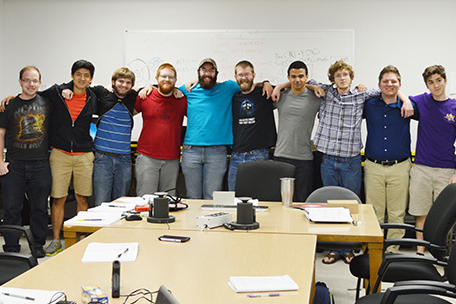NASA Awards Student-Led Team to Develop Lightning Gamma-Ray Instrument
FOR IMMEDIATE RELEASE
April 25, 2016
BATON ROUGE - NASA has awarded a Louisiana Space Grant Consortium, or LaSPACE, research team at LSU a grant to develop an instrument that would fly into a thunderstorm to measure how lightning can produce high energy gamma-rays. The student-led project called, Correlation of Terrestrial gamma flashes, Electric fields and Lightning strikes, or COTEL, is one of 39 projects selected by the NASA Office of Education through the Undergraduate Student Instrument Project, or USIP, program. COTEL has been awarded a $200,000 grant.
The USIP program is intended to build scientific, technical, leadership
and project management skills among undergraduate students by involving them in a
full-cycle project from the design and development through launch and recovery of
a flight instrument relevant to NASA's mission. In addition to LSU, students at Southern
University and A&M College in Baton Rouge, Baton Rouge Community College and River
Parish Community College will also participate in the COTEL project.
The proposed COTEL instrument will include an electric field detector,
gamma-ray detector and lightning detection system to be launched using a sounding
balloon into a thunderstorm cell to measure the electrical and radiation environment
up to 100,000 feet.
According to LSU Department of Physics & Astronomy Professor T. Gregory
Guzik, who is the faculty project lead and director of the Louisiana Space Grant Consortium,
"This is a great training opportunity for our students, who will be involved from
start to finish in a real NASA-funded project."

LSU undergraduate students have been involved since long before the award was announced in early April. During the fall 2015 semester, a student team was established. With mentoring from LSU faculty and staff, the team conceived of the COTEL project proposal that was submitted to NASA last November.
"After several weeks of sifting through project ideas, consulting with our advisors and conducting background research, our student team participated in creating a project proposal with the potential to contribute to the scientific understanding of the Earth’s atmosphere. We were very lucky to have the opportunity to work first hand on a real proposal to a prestigious agency, despite the challenging learning curve and time constraints. Now that we’ve been successfully funded, we’re looking forward to putting our ideas into action over the next year and a half,” said Victor Fernandez-Kim of Baton Rouge, COTEL student team leader.
LSU students who are also currently involved in the COTEL project are David Bordelon of Metairie, La., Jordan Causey of Gonzales, La., Joshua Curtis Collins of LaPlace, La., Allen Davis of Spanish Fort, Ala., Kyle Alexander Hamer of Lafayette, La., Brad Landry of Lockport, La., Adam Majoria of Baton Rouge, Connor L Mayeux of Amite, La. and John Samuel Reid of Denham Springs, La.
The COTEL student project complements another project, TETRA-II, recently awarded by NASA EPSCoR to LSU Department of Physics & Astronomy Professor Michael Cherry to measure gamma-rays from thunderstorms using an array of detectors on the ground. These so-called Terrestrial Gamma Flash, or TGF, events have been observed by Earth-orbiting satellites since 1994, but the TETRA-II and COTEL projects will be the first to study TGF events from the ground and within thunderstorms.
The student team is currently in the process of recruiting members, with an expectation that project activities will ramp up during the summer when preliminary payload designs will be started. The team is expected to work with a NASA engineer during payload definition and development. These designs will be implemented as prototype systems that will be tested during the spring 2017 thunderstorm season.
“One of the major problems the students will need to solve is how to safely fill and launch a weather balloon in the vicinity of a thunderstorm. That is an issue that both NASA and I will be paying very close attention to,” Guzik said.
Upon successful completion of prototype testing, the student team will develop a final version of the payload. This payload will then provide new measurements of the electric field intensity as well as gamma-rays emitted by lightning in the storm as a function of altitude up to 100,000 feet within and above a thunderstorm. These data will be used to help constrain models of how TGF events are generated.
Additional Links:
Louisiana Space Grant Consortium (LaSPACE): LaSPACE.lsu.edu
Louisiana NASA EPSCoR: lanasaepscor.lsu.edu
Louisiana Board of Regents Sponsored Programs: regents.louisiana.gov/sponsored-programs
NASA Space Grant Press Release:http://www.nasa.gov/feature/nasa-selects-proposals-for-student-flight-research-opportunities
NASA Space Grant: Abstracts of All Awarded Projects:http://www.nasa.gov/sites/default/files/atoms/files/space_grant_2015_usip_proposal_abstracts_final.pdf
NASA Space Grant College and Fellowship Program: http://www.nasa.gov/offices/education/programs/national/spacegrant/home/#.VXdAVEZURmM
NASA Experimental Program to Stimulate Competitive Research (EPSCoR): http://www.nasa.gov/offices/education/programs/national/epscor/home/index.html#.VXdAf0ZURmM
-30-
Contact Colleen H. FavaLaSPACE Manager
LSU Department of Physics & Astronomy
225-578-8697
colleenf@lsu.edu
Alison Satake
LSU Media Relations
225-578-3870
asatake@lsu.edu
More news and information can be found on LSU’s media center, www.lsu.edu/mediacenter
Last Updated: April 25, 2016